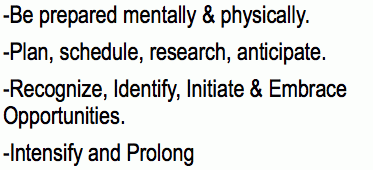This is a minimal outline of the model I have developed since 1984 based on the belief that positive experiences are our most valued personal assets and inner resources, so skills in having positive experiences are the key ability. This anatomy of positive experiences breaks down positive experiences temporally, to identify skill aspects that can be developed. This model has been presented at both the Positive Psychology Summit Meeting and the First Canadian Positive Psychology Meeting.
{1} Be prepared for Positive Experiences (PEs) mentally and physically
Be relaxed and comfortable feeling and expressing strong positive emotions. Maintain healthy habits, positive attitude and self talk so you have robust positive emotional reflexes and lots of bounce and energy to make the most of PE opportunities whenever they appear-- planned or unexpected.
{II} Plan, schedule, research, anticipate PEs--
not just vacations or weekend evenings-- but throughout each day of the week. Study your own behavior patterns, your inner and outer resources and your environment to build a PE knowledge base that helps you zoom in on PE opportunities-- planned or unexpected-- and schedule challenges, fun, pleasure, and good deeds.
{III} Recognize, identify, Initiate and Embrace your PE Opportunities.
Sharpen your skills for recognizing positive experience opportunities and initiating them most effectively. Develop a positive attitude that expects to find and seeks out positive experience opportunities.
{IV} Intensify and Prolong the positive experience.
Increase its complexity, extend its length, enrich its sensory, emotional, social and spiritual content to make the PE more meaningful and memorable.
{V} Encode to memory:
Store the PE (in your brain, diary, photo, audio, video or computer) for integration into your memory, your view of yourself and your relationship with the world. Do a post PE stretch to etch the experience even more solidly into your memory.
{VI} Use the PE later:
Transplant the feelings to new situations, clone it, strengthen your self esteem and positive attitude, face adversity with greater strength, character and equanimity, and brighten your happiness.






